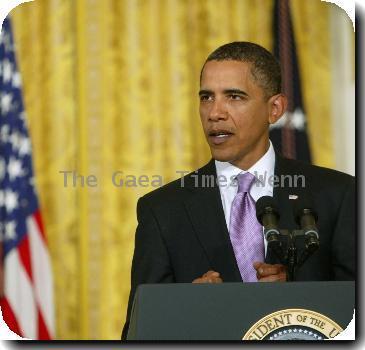Dutch airline KLM says no damage to plane that flew through ash cloud, wants flights resumed
By Karl Ritter, APSunday, April 18, 2010
KLM pushes to resume flights after ash tests
AMSTERDAM — Dutch airline KLM said it safely flew aircraft without passengers through a window in the cloud of volcanic ash over Europe Sunday, and pressed for an end to the total ban on commercial air traffic that has paralyzed travel across the continent.
Other airlines including Lufthansa and Air France said they, too, were conducting test flights. Authorities, however, extended airspace restrictions across Europe and said there was no end in sight to the plume spewing out of a volcano in Iceland, which they insist is dangerous to planes.
KLM said the planes, of various types in its fleet, flew at normal altitude above 10,000 feet but did not encounter the thick cloud that had hovered over the continent since Wednesday, apparently indicating the Icelandic dust had thinned or dispersed.
A KLM spokeswoman said four flights completed the short flight from Duesseldorf in western Germany without incident and four more planes were due to return to their home base at Schiphol Airport. The airline had permission from Dutch and European aviation authorities before sending the planes aloft.
Engineers immediately took the aircraft for inspection as they landed.
Steven Verhagen, vice president of the Dutch Airline Pilots’ Association and a Boeing 737 pilot for KLM, said he would have no qualms about flying today and his 4,000-member organization was calling for a resumption of flights.
“With the weather we are encountering now — clear blue skies and obviously no dense ash cloud to be seen, in our opinion there is absolutely no reason to worry about resuming flights,” he said.
“We are asking the authorities to really have a good look at the situation, because 100 percent safety does not exist,” Verhagen said. “It’s easy to close down air space because then it’s perfectly safe. But at some time you have to resume flights.”
But meteorologists said the situation above Europe was unstable and constantly changing with the varying winds — and the unpredictability was compounded by the volcano’s irregular eruptions spitting more ash into the sky.
The cloud “won’t be present at all parts of the area at risk at all times, you can see clear area, but it will change, it won’t stand still,” said John Hammond of the British Meteorological Office.
Millions of passengers have had plans foiled or delayed because of a ban on air travel that has gradually expanded over large swaths of Europe since Thursday.
The aviation industry, already reeling from a punishing economic period, is facing at least $200 million in losses every day, according to the International Air Transport Association.
KLM, a subsidiary of Air France, began test flights Saturday with a Boeing 737 flying up to 41,000 feet (13,000 meters), the maximum altitude at which the aircraft is certified to fly.
“We observed no irregularities either during the flight or during the initial inspection on the ground,” said Chief Executive Peter Hartman, who was aboard Saturday’s flight.
The airline planned to return seven airplanes without passengers to Amsterdam from Duesseldorf on Sunday.
“We hope to receive permission as soon as possible after that to start up our operation and to transport our passengers to their destinations,” Hartman said in a statement.
German airlines also conducted flights, but at a lower altitude. German restrictions allow such flights, so long as no passengers are on board.
Lufthansa flew 10 empty long-haul planes to Frankfurt from Munich at heights of between 9,800-26,200 feet (3,000-8,000 meters Saturday under so-called visual flight rules, in which pilots don’t have to rely on their instruments, spokesman Wolfgang Weber said.
He stressed that the flights weren’t tests, and were merely intended to get the planes in the right place at the Frankfurt hub for when restrictions are lifted.
“We simply checked every single aircraft very carefully after the landing in Frankfurt to see whether there was any damage that could have been caused by volcanic ash,” Weber said. “Not the slightest scratch was found on any of the 10 planes.”
German air traffic control said Air Berlin and Condor had carried out similar flights.
Air Berlin, Germany’s second-biggest airline, said it had transferred two planes from Munich to Duesseldorf and another from Nuremberg to Hamburg without problems on Saturday. They flew at 9,840 feet (3,000 meters).
A technical inspection of the aircraft after landing “did not reveal any adverse effects,” the company said.
Air Berlin Chief Executive Joachim Hunold declared himself “amazed” that the results of the German airlines’ flights “did not have any influence whatsoever on the decisions taken by the aviation safety authorities.”
Kyla Evans, spokeswoman for the European air traffic control agency Eurocontrol, said it was up to national aviation authorities to decide whether to open up their airspace. The agency’s role was to coordinate traffic once it was allowed to resume.
Scientists say that because the volcano is situated below a glacial ice cap, magma is being cooled quickly, causing explosions and plumes of grit that can be catastrophic to plane engines, depending on prevailing winds.
“Normally, a volcano spews out ash to begin with and then it changes into lava, but here it continues to spew out ash, because of the glacier,” said Reynir Bodvarsson, director of Swedish National Seismic Network. “It is very special.”
Bodvarsson said the relative weakness of the eruption in Iceland also means the ash remains relatively close to the earth, while a stronger eruption would have catapulted the ash outside of the atmosphere.
In 1989, a KLM Boeing 747 that flew through a volcanic ash cloud above Alaska temporarily lost all four motors. The motors restarted at a lower altitude and the plane eventually landed safely.
The Center for Asia Pacific Aviation, an independent aviation research group based in Sydney, Australia, said it remained unclear whether the closure of much of Europe’s airspace was “a massive overreaction of super-cautious politicians and bureaucrats,” or a genuinely serious event.
The group noted that a similar eruption under a glacier in Iceland in the 1990s, led to minimal disruption, with flights routed around the area.
“It certainly did not lead to region-wide closures of air space. Such has the paranoia around safety and security grown since September 11,” the center said in a statement.
The Swiss Federal Office of Civil Aviation began allowing flights Saturday above Swiss air space as long as the aircraft were at least at 36,000 feet (11,000 meters). It also allowed flights at lower altitudes under visual flight rules, aimed at small, private aircraft.
Air France said it will conduct test flights “to improve knowledge of the impact of the ash cloud on airplanes.” The first flight, in an Airbus A320 carrying no passengers, was to take off Sunday afternoon from an unspecified location in southwest France.
The planes would undergo inspections afterward, Air France said, adding it got approval from the French civil aviation authority for the flights and is in touch with other European airlines doing the same thing.
Germany extended closure of its airports through 1800GMT Sunday and Britain until 0000 GMT. Dutch restrictions also remained in place, though the Dutch Transport Ministry said it was allowing further test flights.
“The goal of these test flights is to make measurements in Dutch airspace about the possible consequences of the ash on the airplane parts, the ministry said in a statement.
Airspace remained closed in Denmark, Finland and most parts of Sweden on Sunday. In Norway, authorities lifted air travel restrictions in the central part of the country, but kept airspace closed in other parts of the country, including the capital, Oslo.
Several world leaders, including President Barack Obama, had to abandon plans to attend the state funeral for Polish President Lech Kaczynski because of ash-related disruptions. Some low-level flights were being allowed in southern Poland, which is how the Polish Air Force was able to ferry the coffins of Kaczynski and his wife from Warsaw to Krakow aboard a prop-powered military cargo plane early Sunday morning.
Southern Iceland’s Eyjafjallajokull (ay-yah-FYAH’-plah-yer-kuh-duhl) volcano began erupting for the second time in a month on Wednesday, sending ash several miles (kilometers) into the air. Winds have pushed the plume south and east across Britain, Ireland, Scandinavia and into the heart of Europe.
The eruption is ongoing and forecasters said light prevailing winds in Europe — and large amounts of unmelted glacial ice above the volcano — mean that the situation in the air is unlikely to change in the coming days.
Around the world, anxious passengers have told stories of missed weddings, business deals and holidays because of the ominous plume. Stranded passengers reported the delays were causing financial hardships. Some had to check out of hotels and sleep in airports.
German Chancellor Angela Merkel was heading homeward Sunday in an armored car after spending the night in northern Italy — continuing a long and circuitous return from the United States.
Merkel was diverted to Portugal and continued to Rome on Saturday. The chancellor’s delegation then took to Italy’s highways in a convoy of an armored car and buses.
In Iceland, torrents of water have carried away chunks of ice the size of small houses. More floods from melting waters are expected as long as the volcano keeps erupting — and in 1821, the same volcano managed to erupt for more than a year.
Ritter reported from Stockholm. Associated Press Writers Toby Sterling and Mike Corder in Amsterdam, Slobodan Lekic in Brussels, Angela Charlton in Paris and Malin Rising in Stockholm contributed to this report.
Tags: Air Travel, Amsterdam, Barack Obama, Eastern Europe, Europe, Frankfurt, Germany, Government Regulations, Iceland, Munich, Netherlands, Poland, Stockholm, Sweden, Transportation, Travel Laws And Regulations, Western Europe

